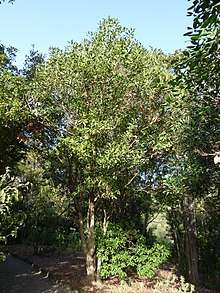Picconia
| Picconia | |
|---|---|
 | |
| Scientific classification | |
| Kingdom: | Plantae |
| Clade: | Angiosperms |
| Clade: | Eudicots |
| Clade: | Asterids |
| Order: | Lamiales |
| Family: | Oleaceae |
| Tribe: | Oleeae |
| Subtribe: | Oleinae |
| Genus: | Picconia DC. |
| Species | |
|
See text | |
Picconia is a genus of two species flowering plants in the family Oleaceae, found in the laurel forests habitat, of Macaronesia.[1]
Description
They are evergreen shrubs to trees with large, opposite, entire, shiny, ovoid leaves and numerous flowers. The fruit is a drupe. The flowers are small white and fragrant, followed by one-seeded, olive-like green fruit, ripening to bluish-black.[2] Picconia are native of open spots in the laurel forest of the Canary Islands and Madeira where they are found only in the humid to hyper-humid evergreen forests of the cloud belt.[3] Tree species with laurel-shaped leaves are predominant, forming a dense canopy up to 40 m high that can be hardly trespassed by light, which results in scant vegetation in the understory.[3] Most of these tree species in Africa are ancient paleoendemic[4] species of the genera Laurus, Ocotea, Persea, and Picconia, which in ancient times were widely distributed on the African and European continents.[3][4]
Species
- Picconia azorica - endemic to the archipelago of the Azores[5]
- Picconia excelsa - tree up to 15m; Madeira, Canaries
References
- ↑ "Vegetative Propagation Of The Endangered Azorean Tree Picconia Azorica". biblioteca.universia.net.
- ↑ "Picconia --- Rareplants.eu Shop". www.rareplants.de.
- 1 2 3 http://ec.europa.eu/environment/nature/natura2000/management/habitats/pdf/9360_Macaronesian_laurel_forests.pdf
- 1 2 Warren, Ben H.; Hawkins, Julie A. (7 September 2006). "The distribution of species diversity across a flora's component lineages: dating the Cape's 'relicts'". Proceedings of the Royal Society of London B: Biological Sciences. 273 (1598): 2149–2158. doi:10.1098/rspb.2006.3560. PMC 1635518. PMID 16901834 – via rspb.royalsocietypublishing.org.
- ↑ Secretaria Regional do Ambiente e do Mar (2008), Plantas Endémicas dos Açores: Guia da Ilha do Faial, p.13
External links
![]()